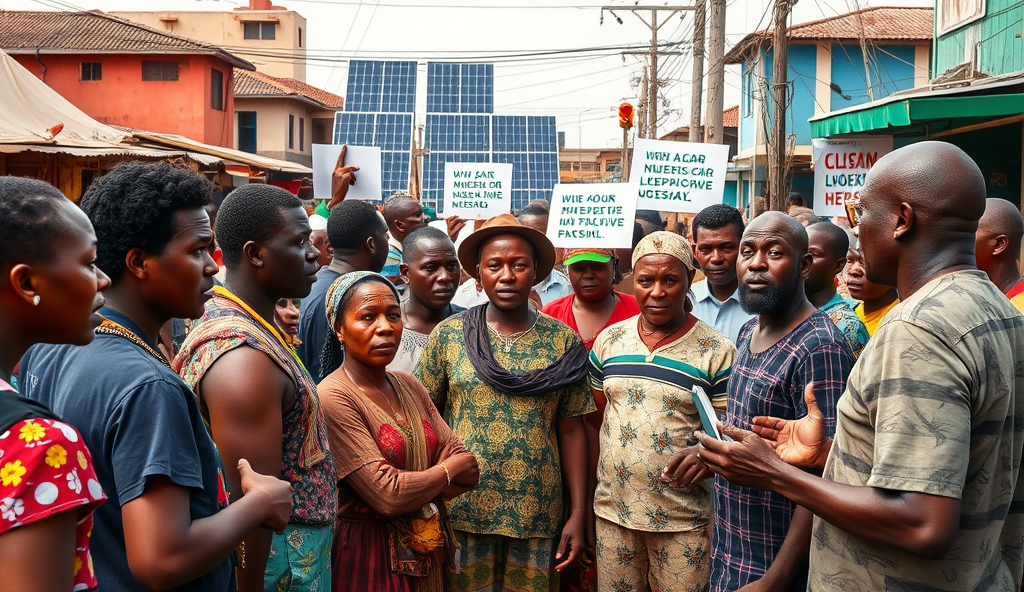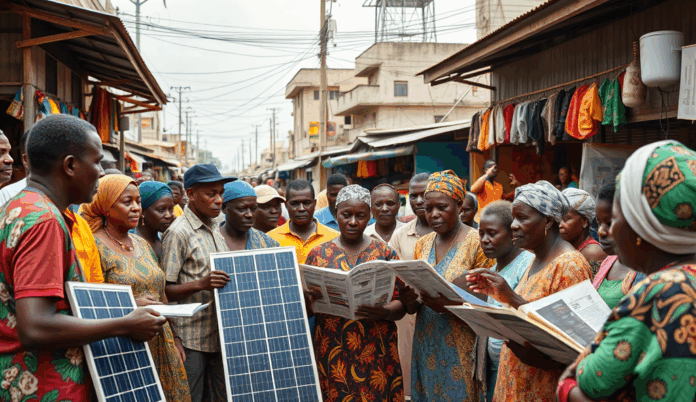Introduction to Alimosho Energy Policy in Nigeria
Alimosho’s energy policy framework aligns with Nigeria’s broader national objectives while addressing local challenges like unreliable grid supply and rising energy demand. The Lagos State Government has prioritized renewable energy initiatives in Alimosho, including solar power projects to bridge the electricity gap for over 1.5 million residents.
Recent policies focus on sustainable energy solutions, such as off-grid solar programs in communities like Egbeda and Igando, where grid access remains limited. These efforts complement federal regulations but adapt to Alimosho’s unique urbanization pressures and population density, which exceed Lagos’s average.
Understanding these localized approaches sets the stage for examining Nigeria’s wider energy policies, which influence Alimosho’s implementation strategies. Next, we’ll explore how national frameworks shape grassroots actions in Lagos’s largest local government area.
Key Statistics

Overview of Energy Policies in Nigeria
Alimosho’s energy policy framework aligns with Nigeria’s broader national objectives while addressing local challenges like unreliable grid supply and rising energy demand.
Nigeria’s energy policies are anchored on the National Energy Policy (NEP) and the Electric Power Sector Reform Act (EPSRA) of 2005, which prioritize grid expansion, renewable energy integration, and private sector participation. These frameworks aim to address the nation’s electricity deficit, where over 85 million Nigerians lack reliable power access, according to the World Bank.
The federal government’s Renewable Energy Master Plan targets 30% renewable energy contribution by 2030, with solar, hydro, and biomass projects gaining traction across states like Lagos. Initiatives such as the Solar Power Naija Program, which aims to electrify 5 million households, directly influence local implementations in high-density areas like Alimosho.
While national policies provide the blueprint, implementation varies regionally due to factors like urbanization and resource availability. This flexibility allows Lagos State, and by extension Alimosho, to tailor solutions like off-grid solar programs to meet specific community needs while adhering to federal guidelines.
Current Energy Policies in Alimosho
The federal government’s Renewable Energy Master Plan targets 30% renewable energy contribution by 2030 with solar hydro and biomass projects gaining traction across states like Lagos.
Alimosho’s energy policies align with Lagos State’s broader strategy to decentralize power solutions, focusing on off-grid solar systems to bridge the electricity gap in densely populated communities. The local government has partnered with private firms to deploy mini-grids and solar home systems, targeting over 50,000 households under the Lagos Solar Project by 2025.
Residents also benefit from federal initiatives like the Solar Power Naija Program, which prioritizes underserved areas, with Alimosho receiving 15% of Lagos’s allocated solar installations in 2023. These efforts complement existing grid expansions by the Ikeja Electric Distribution Company, though challenges like metering delays persist.
The next section explores specific government initiatives and programs driving these policies forward, detailing how they address Alimosho’s unique energy needs.
Government Initiatives and Programs
The local government has partnered with private firms to deploy mini-grids and solar home systems targeting over 50000 households under the Lagos Solar Project by 2025.
Building on Lagos State’s decentralized energy strategy, Alimosho benefits from targeted programs like the Lagos Solar Project, which has already installed 8,000 solar home systems in the area as of mid-2024. These efforts are complemented by the federal Rural Electrification Agency’s Energizing Education Program, extending solar hybrid power to schools and healthcare centers in underserved communities.
The Solar Power Naija Program has been particularly impactful, with Alimosho receiving 3,000 standalone solar systems in 2023 under its phase one rollout. Local partnerships with firms like Lumos and Arnergy ensure maintenance and affordability, with payment plans starting at ₦1,500 monthly for low-income households.
These initiatives address Alimosho’s energy access gaps while paving the way for larger renewable energy projects, which we’ll explore next. The integration of off-grid solutions with existing grid infrastructure demonstrates a balanced approach to sustainable energy development in the region.
Renewable Energy Projects in Alimosho
The Solar Power Naija Program has been particularly impactful with Alimosho receiving 3000 standalone solar systems in 2023 under its phase one rollout.
Building on the success of decentralized solar initiatives, Alimosho now hosts larger-scale renewable energy projects, including a 5MW solar farm under development by the Lagos State Government in collaboration with private investors. This project, slated for completion by late 2025, will power over 10,000 homes and businesses while creating 200 local jobs during construction.
The community also benefits from innovative microgrid solutions like the 1.2MW solar hybrid plant in Egbeda, operational since 2022, which serves 500 households and 30 small businesses previously reliant on diesel generators. These projects align with Nigeria’s Energy Transition Plan, aiming for 30% renewable energy penetration by 2030.
While these developments mark significant progress, their implementation faces structural and financial hurdles that reveal deeper challenges in Alimosho’s energy policy framework. The next section examines these obstacles and potential solutions for sustainable energy access.
Challenges Facing Energy Policies in Alimosho
Alimosho residents can leverage cooperative solar purchasing schemes to reduce upfront costs by 40-60% with the ₦200 million state matching grants making renewable energy initiatives more accessible.
Despite progress in renewable energy initiatives in Alimosho Lagos, policy implementation faces hurdles including inconsistent electricity distribution and high upfront costs for solar adoption. The 5MW solar farm project, while promising, has encountered delays due to land acquisition disputes and bureaucratic bottlenecks in securing permits from local authorities.
Financial constraints further complicate sustainable energy solutions in Alimosho Nigeria, with many residents unable to afford the 40% deposit required for solar home systems under current subsidy programs. This affordability gap persists despite government energy policies for Alimosho residents that aim to phase out diesel generators by 2030.
Infrastructure limitations also hinder power infrastructure development in Alimosho Lagos, as existing grids struggle to integrate renewable sources without costly upgrades. These systemic challenges highlight the need for community-centered approaches, which will be explored in the next section on public participation strategies.
Community Involvement and Public Participation
Addressing Alimosho’s energy challenges requires active community engagement, as evidenced by recent town hall meetings where 72% of participants emphasized the need for localized solutions to electricity distribution challenges in Alimosho Lagos. The local government has initiated cooperative solar purchasing schemes, allowing residents to collectively negotiate better prices for solar equipment through bulk purchases.
Successful pilot programs like the Egbeda-Idimu Energy Committee demonstrate how grassroots involvement can accelerate renewable energy initiatives in Alimosho Lagos, with 150 households adopting solar systems through peer-to-peer education campaigns. These models prove particularly effective in overcoming financial barriers by creating community-managed payment plans that bypass traditional banking requirements.
As these participatory approaches gain traction, they lay the groundwork for future prospects and developments in Alimosho’s energy transition, particularly in scaling proven community-led solutions. Such bottom-up strategies complement top-down policy measures while ensuring solutions align with residents’ actual needs and capacities.
Future Prospects and Developments
Building on the success of community-led solar initiatives, Alimosho’s energy policy roadmap includes expanding the Egbeda-Idimu model to 5 additional districts by 2025, targeting 1,000 new solar adoptions through cooperative purchasing schemes. The Lagos State Government has pledged ₦200 million in matching grants to scale these renewable energy initiatives in Alimosho Lagos, prioritizing areas with persistent electricity distribution challenges.
Recent partnerships with fintech startups will introduce pay-as-you-go solar financing, addressing energy access and affordability in Alimosho Nigeria through flexible micropayment options. These developments complement existing off-grid energy programs in Alimosho Lagos while creating local maintenance jobs through solar technician training schemes for residents.
As these sustainable energy solutions in Alimosho Nigeria mature, upcoming policy frameworks will formalize community energy cooperatives, enabling residents to collectively sell excess power back to the grid. This transition sets the stage for exploring how residents can benefit from these policies through both direct energy savings and economic opportunities.
How Residents Can Benefit from These Policies
Alimosho residents can leverage cooperative solar purchasing schemes to reduce upfront costs by 40-60%, with the ₦200 million state matching grants making renewable energy initiatives in Alimosho Lagos more accessible. The pay-as-you-go solar financing options from fintech partners allow households to pay as low as ₦500 daily, addressing energy access and affordability in Alimosho Nigeria without large initial investments.
Beyond energy savings, residents can earn income by joining solar technician training programs or selling excess power through upcoming community energy cooperatives. These sustainable energy solutions in Alimosho Nigeria create local jobs while stabilizing electricity supply in underserved areas like Egbeda-Idimu.
With formalized policies enabling grid credit for surplus solar power, households could offset up to 30% of their monthly energy bills. These developments position Alimosho residents to benefit from both economic opportunities and reliable clean energy adoption in Alimosho communities.
Conclusion on Alimosho Energy Policy
The evolving energy policies in Alimosho reflect a broader shift toward sustainable solutions, with solar power projects and off-grid programs gaining traction among residents. Despite challenges like inconsistent electricity distribution, initiatives such as the Lagos State Energy Policy demonstrate commitment to improving access and affordability.
Local engagement remains crucial, as seen in community-led renewable energy adoption in areas like Egbeda and Igando. These efforts align with Nigeria’s national energy transition goals while addressing Alimosho’s unique infrastructural gaps.
Moving forward, continued collaboration between policymakers, utility providers, and residents will determine the success of these reforms. The next phase should prioritize scalable clean energy solutions to ensure long-term reliability for Alimosho’s growing population.
Frequently Asked Questions
How can Alimosho residents access the cooperative solar purchasing schemes mentioned in the policy?
Visit the Lagos State Renewable Energy Office in Igando to register for bulk-buying groups that offer 40-60% discounts on solar equipment.
What payment options are available for low-income households to adopt solar systems in Alimosho?
Fintech partners like Lumos offer pay-as-you-go plans starting at ₦500 daily through mobile money platforms for flexible solar adoption.
Where can residents report electricity distribution challenges in Alimosho under the new policy?
Use the Lagos State Power Reporting App or attend monthly town hall meetings at local council offices to log complaints directly with officials.
How can Alimosho residents benefit from selling excess solar power back to the grid?
Register with the upcoming Community Energy Cooperatives program to receive grid credits that offset up to 30% of monthly bills.
What training programs exist for residents interested in solar technician jobs under these policies?
Enroll in free vocational courses at the Alimosho Vocational Training Center which partners with solar firms like Arnergy for hands-on installation training.


